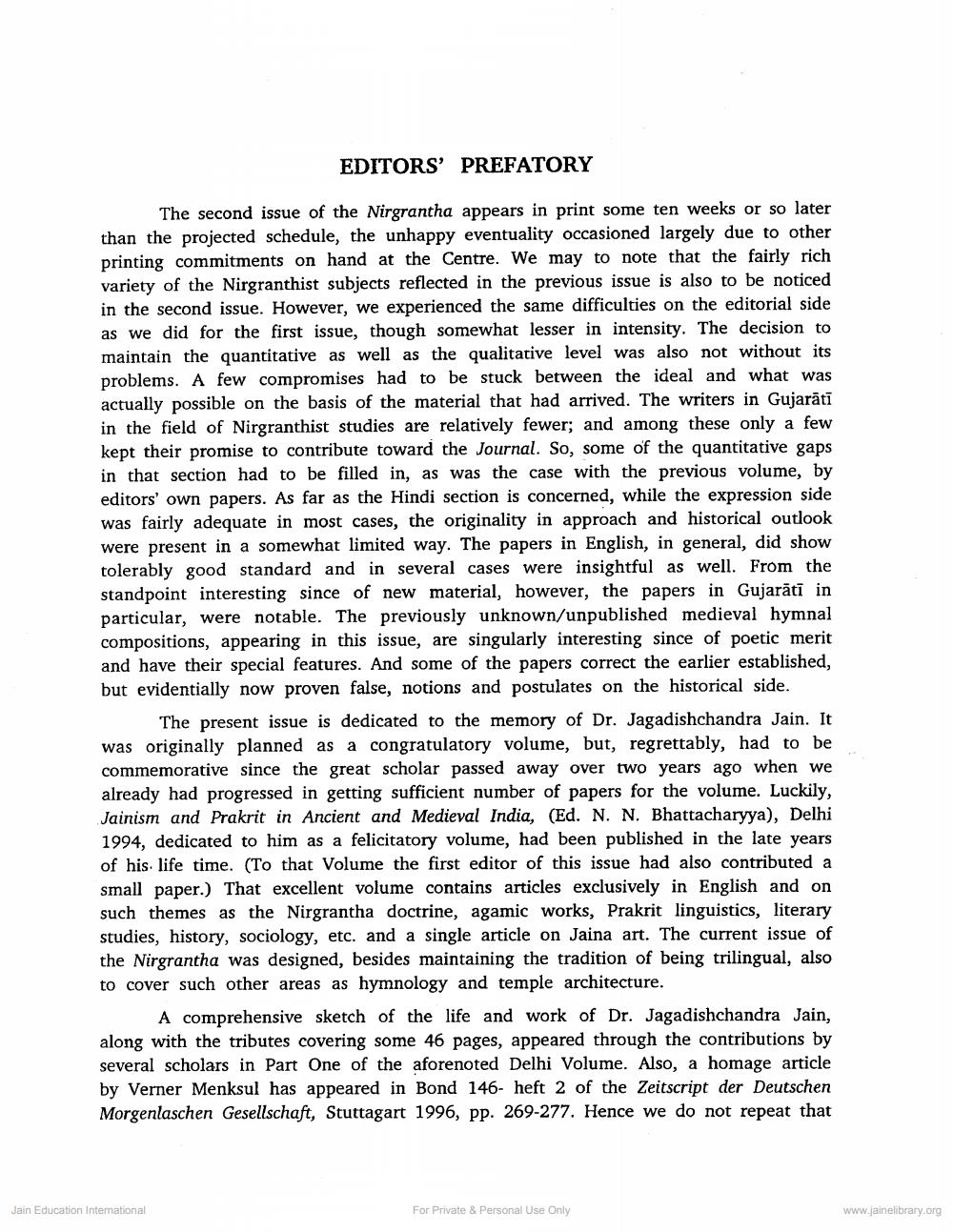Book Title: Nirgrantha-2 Author(s): M A Dhaky, Jitendra B Shah Publisher: Shardaben Chimanbhai Educational Research Centre View full book textPage 9
________________ EDITORS' PREFATORY The second issue of the Nigrantha appears in print some ten weeks or so later than the projected schedule, the unhappy eventuality occasioned largely due to other printing commitments on hand at the Centre. We may to note that the fairly rich variety of the Nirgranthist subjects reflected in the previous issue is also to be noticed in the second issue. However, we experienced the same difficulties on the editorial side as we did for the first issue, though somewhat lesser in intensity. The decision to maintain the quantitative as well as the qualitative level was also not without its problems. A few compromises had to be stuck between the ideal and what was actually possible on the basis of the material that had arrived. The writers in Gujarati in the field of Nirgranthist studies are relatively fewer; and among these only a few kept their promise to contribute toward the Journal. So, some of the quantitative gaps in that section had to be filled in, as was the case with the previous volume, by editors' own papers. As far as the Hindi section is concerned, while the expression side was fairly adequate in most cases, the originality in approach and historical outlook were present in a somewhat limited way. The papers in English, in general, did show tolerably good standard and in several cases were insightful as well. From the standpoint interesting since of new material, however, the papers in Gujarāti in particular, were notable. The previously unknown/unpublished medieval hymnal compositions, appearing in this issue, are singularly interesting since of poetic merit and have their special features. And some of the papers correct the earlier established, but evidentially now proven false, notions and postulates on the historical side. The present issue is dedicated to the memory of Dr. Jagadishchandra Jain. It was originally planned as a congratulatory volume, but, regrettably, had to be commemorative since the great scholar passed away over two years ago when we already had progressed in getting sufficient number of papers for the volume. Luckily, Jainism and Prakrit in Ancient and Medieval India, (Ed. N. N. Bhattacharyya), Delhi 1994, dedicated to him as a felicitatory volume, had been published in the late years of his life time. (To that Volume the first editor of this issue had also contributed a small paper.) That excellent volume contains articles exclusively in English and on such themes as the Nirgrantha doctrine, agamic works, Prakrit linguistics, literary studies, history, sociology, etc. and a single article on Jaina art. The current issue of the Nirgrantha was designed, besides maintaining the tradition of being trilingual, also to cover such other areas as hymnology and temple architecture. A comprehensive sketch of the life and work of Dr. Jagadishchandra Jain, along with the tributes covering some 46 pages, appeared through the contributions by several scholars in Part One of the aforenoted Delhi Volume. Also, a homage article by Verner Menksul has appeared in Bond 146- heft 2 of the Zeitscript der Deutschen Morgenlaschen Gesellschaft, Stuttagart 1996, pp. 269-277. Hence we do not repeat that Jain Education International For Private & Personal Use Only www.jainelibrary.orgPage Navigation
1 ... 7 8 9 10 11 12 13 14 15 16 17 18 19 20 21 22 23 24 25 26 27 28 29 30 31 32 33 34 35 36 37 38 39 40 41 42 43 44 45 46 47 48 49 50 51 52 53 54 55 56 57 58 59 60 61 62 63 64 65 66 67 68 69 70 71 72 73 74 75 76 77 78 79 80 81 82 83 84 85 86 87 88 89 90 91 92 ... 326
